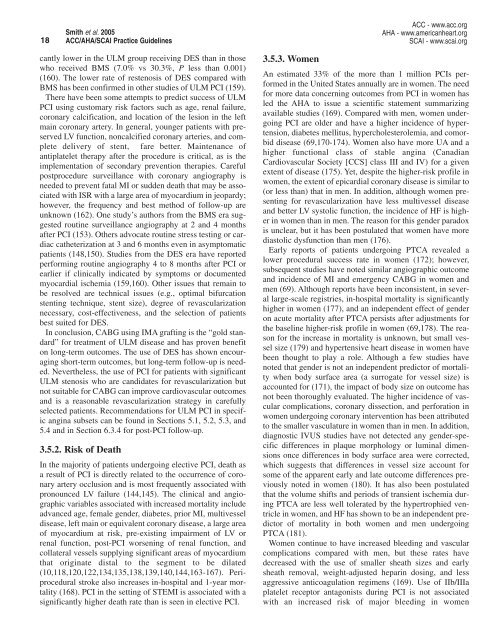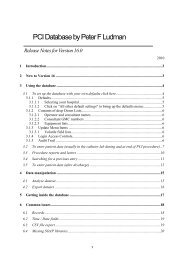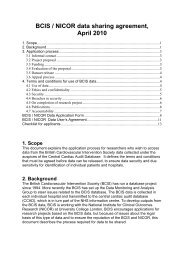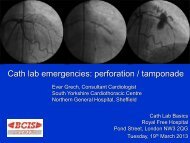Recommendations
ACC/AHA/SCAI PCI Guidelines - British Cardiovascular Intervention ...
ACC/AHA/SCAI PCI Guidelines - British Cardiovascular Intervention ...
- No tags were found...
Create successful ePaper yourself
Turn your PDF publications into a flip-book with our unique Google optimized e-Paper software.
18<br />
Smith et al. 2005<br />
ACC/AHA/SCAI Practice Guidelines<br />
ACC - www.acc.org<br />
AHA - www.americanheart.org<br />
SCAI - www.scai.org<br />
cantly lower in the ULM group receiving DES than in those<br />
who received BMS (7.0% vs 30.3%, P less than 0.001)<br />
(160). The lower rate of restenosis of DES compared with<br />
BMS has been confirmed in other studies of ULM PCI (159).<br />
There have been some attempts to predict success of ULM<br />
PCI using customary risk factors such as age, renal failure,<br />
coronary calcification, and location of the lesion in the left<br />
main coronary artery. In general, younger patients with preserved<br />
LV function, noncalcified coronary arteries, and complete<br />
delivery of stent, fare better. Maintenance of<br />
antiplatelet therapy after the procedure is critical, as is the<br />
implementation of secondary prevention therapies. Careful<br />
postprocedure surveillance with coronary angiography is<br />
needed to prevent fatal MI or sudden death that may be associated<br />
with ISR with a large area of myocardium in jeopardy;<br />
however, the frequency and best method of follow-up are<br />
unknown (162). One study’s authors from the BMS era suggested<br />
routine surveillance angiography at 2 and 4 months<br />
after PCI (153). Others advocate routine stress testing or cardiac<br />
catheterization at 3 and 6 months even in asymptomatic<br />
patients (148,150). Studies from the DES era have reported<br />
performing routine angiography 4 to 8 months after PCI or<br />
earlier if clinically indicated by symptoms or documented<br />
myocardial ischemia (159,160). Other issues that remain to<br />
be resolved are technical issues (e.g., optimal bifurcation<br />
stenting technique, stent size), degree of revascularization<br />
necessary, cost-effectiveness, and the selection of patients<br />
best suited for DES.<br />
In conclusion, CABG using IMA grafting is the “gold standard”<br />
for treatment of ULM disease and has proven benefit<br />
on long-term outcomes. The use of DES has shown encouraging<br />
short-term outcomes, but long-term follow-up is needed.<br />
Nevertheless, the use of PCI for patients with significant<br />
ULM stenosis who are candidates for revascularization but<br />
not suitable for CABG can improve cardiovascular outcomes<br />
and is a reasonable revascularization strategy in carefully<br />
selected patients. <strong>Recommendations</strong> for ULM PCI in specific<br />
angina subsets can be found in Sections 5.1, 5.2, 5.3, and<br />
5.4 and in Section 6.3.4 for post-PCI follow-up.<br />
3.5.2. Risk of Death<br />
In the majority of patients undergoing elective PCI, death as<br />
a result of PCI is directly related to the occurrence of coronary<br />
artery occlusion and is most frequently associated with<br />
pronounced LV failure (144,145). The clinical and angiographic<br />
variables associated with increased mortality include<br />
advanced age, female gender, diabetes, prior MI, multivessel<br />
disease, left main or equivalent coronary disease, a large area<br />
of myocardium at risk, pre-existing impairment of LV or<br />
renal function, post-PCI worsening of renal function, and<br />
collateral vessels supplying significant areas of myocardium<br />
that originate distal to the segment to be dilated<br />
(10,118,120,122,134,135,138,139,140,144,163-167). Periprocedural<br />
stroke also increases in-hospital and 1-year mortality<br />
(168). PCI in the setting of STEMI is associated with a<br />
significantly higher death rate than is seen in elective PCI.<br />
3.5.3. Women<br />
An estimated 33% of the more than 1 million PCIs performed<br />
in the United States annually are in women. The need<br />
for more data concerning outcomes from PCI in women has<br />
led the AHA to issue a scientific statement summarizing<br />
available studies (169). Compared with men, women undergoing<br />
PCI are older and have a higher incidence of hypertension,<br />
diabetes mellitus, hypercholesterolemia, and comorbid<br />
disease (69,170-174). Women also have more UA and a<br />
higher functional class of stable angina (Canadian<br />
Cardiovascular Society [CCS] class III and IV) for a given<br />
extent of disease (175). Yet, despite the higher-risk profile in<br />
women, the extent of epicardial coronary disease is similar to<br />
(or less than) that in men. In addition, although women presenting<br />
for revascularization have less multivessel disease<br />
and better LV systolic function, the incidence of HF is higher<br />
in women than in men. The reason for this gender paradox<br />
is unclear, but it has been postulated that women have more<br />
diastolic dysfunction than men (176).<br />
Early reports of patients undergoing PTCA revealed a<br />
lower procedural success rate in women (172); however,<br />
subsequent studies have noted similar angiographic outcome<br />
and incidence of MI and emergency CABG in women and<br />
men (69). Although reports have been inconsistent, in several<br />
large-scale registries, in-hospital mortality is significantly<br />
higher in women (177), and an independent effect of gender<br />
on acute mortality after PTCA persists after adjustments for<br />
the baseline higher-risk profile in women (69,178). The reason<br />
for the increase in mortality is unknown, but small vessel<br />
size (179) and hypertensive heart disease in women have<br />
been thought to play a role. Although a few studies have<br />
noted that gender is not an independent predictor of mortality<br />
when body surface area (a surrogate for vessel size) is<br />
accounted for (171), the impact of body size on outcome has<br />
not been thoroughly evaluated. The higher incidence of vascular<br />
complications, coronary dissection, and perforation in<br />
women undergoing coronary intervention has been attributed<br />
to the smaller vasculature in women than in men. In addition,<br />
diagnostic IVUS studies have not detected any gender-specific<br />
differences in plaque morphology or luminal dimensions<br />
once differences in body surface area were corrected,<br />
which suggests that differences in vessel size account for<br />
some of the apparent early and late outcome differences previously<br />
noted in women (180). It has also been postulated<br />
that the volume shifts and periods of transient ischemia during<br />
PTCA are less well tolerated by the hypertrophied ventricle<br />
in women, and HF has shown to be an independent predictor<br />
of mortality in both women and men undergoing<br />
PTCA (181).<br />
Women continue to have increased bleeding and vascular<br />
complications compared with men, but these rates have<br />
decreased with the use of smaller sheath sizes and early<br />
sheath removal, weight-adjusted heparin dosing, and less<br />
aggressive anticoagulation regimens (169). Use of IIb/IIIa<br />
platelet receptor antagonists during PCI is not associated<br />
with an increased risk of major bleeding in women
















